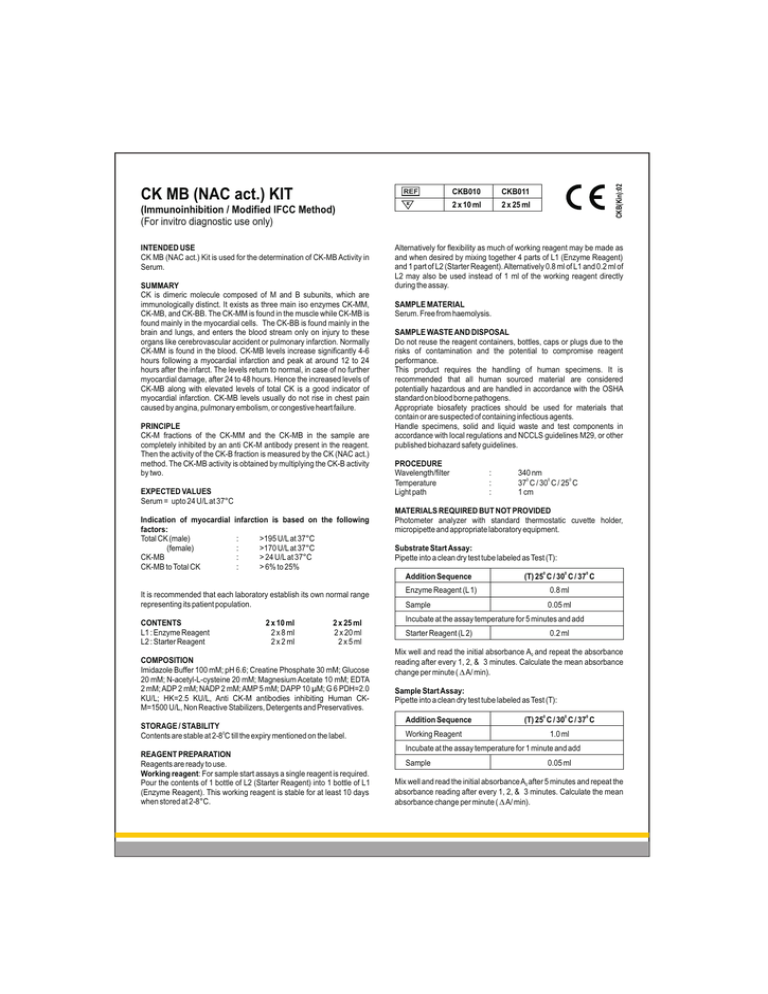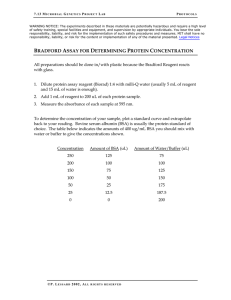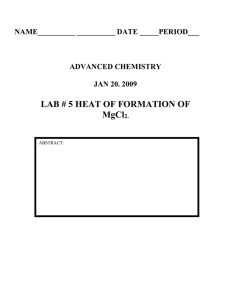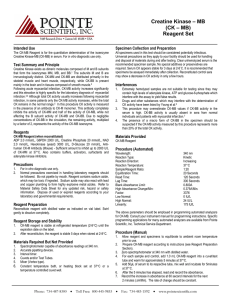CK MB Nac act Kit - The Tulip Group, India
advertisement

REF (Immunoinhibition / Modified IFCC Method) (For invitro diagnostic use only) INTENDED USE CK MB (NAC act.) Kit is used for the determination of CK-MB Activity in Serum. SUMMARY CK is dimeric molecule composed of M and B subunits, which are immunologically distinct. It exists as three main iso enzymes CK-MM, CK-MB, and CK-BB. The CK-MM is found in the muscle while CK-MB is found mainly in the myocardial cells. The CK-BB is found mainly in the brain and lungs, and enters the blood stream only on injury to these organs like cerebrovascular accident or pulmonary infarction. Normally CK-MM is found in the blood. CK-MB levels increase significantly 4-6 hours following a myocardial infarction and peak at around 12 to 24 hours after the infarct. The levels return to normal, in case of no further myocardial damage, after 24 to 48 hours. Hence the increased levels of CK-MB along with elevated levels of total CK is a good indicator of myocardial infarction. CK-MB levels usually do not rise in chest pain caused by angina, pulmonary embolism, or congestive heart failure. PRINCIPLE CK-M fractions of the CK-MM and the CK-MB in the sample are completely inhibited by an anti CK-M antibody present in the reagent. Then the activity of the CK-B fraction is measured by the CK (NAC act.) method. The CK-MB activity is obtained by multiplying the CK-B activity by two. EXPECTED VALUES Serum = upto 24 U/L at 37°C Indication of myocardial factors: Total CK (male) (female) CK-MB CK-MB to Total CK CKB011 2 x 25 ml Alternatively for flexibility as much of working reagent may be made as and when desired by mixing together 4 parts of L1 (Enzyme Reagent) and 1 part of L2 (Starter Reagent). Alternatively 0.8 ml of L1 and 0.2 ml of L2 may also be used instead of 1 ml of the working reagent directly during the assay. SAMPLE MATERIAL Serum. Free from haemolysis. SAMPLE WASTE AND DISPOSAL Do not reuse the reagent containers, bottles, caps or plugs due to the risks of contamination and the potential to compromise reagent performance. This product requires the handling of human specimens. It is recommended that all human sourced material are considered potentially hazardous and are handled in accordance with the OSHA standard on blood borne pathogens. Appropriate biosafety practices should be used for materials that contain or are suspected of containing infectious agents. Handle specimens, solid and liquid waste and test components in accordance with local regulations and NCCLS guidelines M29, or other published biohazard safety guidelines. PROCEDURE Wavelength/filter Temperature Light path : : : 340 nm 370 C / 300 C / 250 C 1 cm infarction is based on the following MATERIALS REQUIRED BUT NOT PROVIDED Photometer analyzer with standard thermostatic cuvette holder, micropipette and appropriate laboratory equipment. : : : : Substrate Start Assay: Pipette into a clean dry test tube labeled as Test (T): >195 U/L at 37°C >170 U/L at 37°C > 24 U/L at 37°C > 6% to 25% Addition Sequence It is recommended that each laboratory establish its own normal range representing its patient population. CONTENTS L1 : Enzyme Reagent L2 : Starter Reagent CKB010 2 x 10 ml CKB(Kin):02 CK MB (NAC act.) KIT 2 x 10 ml 2 x 8 ml 2 x 2 ml 2 x 25 ml 2 x 20 ml 2 x 5 ml COMPOSITION Imidazole Buffer 100 mM; pH 6.6; Creatine Phosphate 30 mM; Glucose 20 mM; N-acetyl-L-cysteine 20 mM; Magnesium Acetate 10 mM; EDTA 2 mM; ADP 2 mM; NADP 2 mM; AMP 5 mM; DAPP 10 µM; G 6 PDH=2.0 KU/L; HK=2.5 KU/L, Anti CK-M antibodies inhibiting Human CKM=1500 U/L, Non Reactive Stabilizers, Detergents and Preservatives. STORAGE / STABILITY Contents are stable at 2-80C till the expiry mentioned on the label. REAGENT PREPARATION Reagents are ready to use. Working reagent: For sample start assays a single reagent is required. Pour the contents of 1 bottle of L2 (Starter Reagent) into 1 bottle of L1 (Enzyme Reagent). This working reagent is stable for at least 10 days when stored at 2-8°C. (T) 250 C / 300 C / 370 C Enzyme Reagent (L 1) 0.8 ml Sample 0.05 ml Incubate at the assay temperature for 5 minutes and add Starter Reagent (L 2) 0.2 ml Mix well and read the initial absorbance A0 and repeat the absorbance reading after every 1, 2, & 3 minutes. Calculate the mean absorbance change per minute ( D A/ min). Sample Start Assay: Pipette into a clean dry test tube labeled as Test (T): Addition Sequence Working Reagent (T) 250 C / 300 C / 370 C 1.0 ml Incubate at the assay temperature for 1 minute and add Sample 0.05 ml Mix well and read the initial absorbance A0 after 5 minutes and repeat the absorbance reading after every 1, 2, & 3 minutes. Calculate the mean absorbance change per minute ( D A/ min). CALCULATIONS Substrate / Sample start CK - B activity in U/L 250 C / 300 C / 370 C = D A/ min. x 3333 CK - MB activity in U/L 250 C / 300 C / 370 C = D A/ min. x 6666 Method comparison: Comparative studies were done to compare our reagent with another commercial CK MB (NAC act.) Assay. No significant differences were observed. Details of the comparative studies are available on request. QUALITY CONTROL The following process is recommended for QC during the assay of CK MB (NAC act.) Kit. *Define and establish acceptable range for your laboratory. 1. Two levels of control (Normal and Abnormal) are to be run on a daily basis. 2. If QC results fall outside acceptance criteria, recalibration may be necessary. 3. Review QC results and run acceptance criteria following a change of reagent lot. TEMPERATURE CONVERSION FACTORS Assay Temperature Limit of detection: The limit of detection for CK MB (NAC act.) Kit is 6 U/L. Interferences: For diagnostic purposes, the results should always be assessed in conjunction with the patient’s medical history, clinical examination and other findings. Between-run 1.00 1.56 2.44 0.64 1.00 1.56 370C 0.41 0.63 1.00 REFERENCES 1. IFCC methods for the measurement of catalytic concentrations of enzymes, JIFCC. (1989) 1 : 130. 2. Clinical Chemistry, Principles, Procedures, Correlations, Michael L. Bishop et.al., 5th Edition. 3. Data on file: Coral Clinical Systems. Precision: Precision studies were performed with two controls using NCCLS protocol EP5-A. The results of the precision studies are shown below: Within-run 250C 300C NOTE This method will also measure any CK-BB isoenzyme present in the sample. The amount of CK-BB is usually negligible in serum from normal individuals or in patients with myocardial infarction. A macro form of BB has been observed and this will be measured as CKB activity. If the CK-B activity exceeds 20% of the total CK activity the presence of macro BB should be suspected. The working reagent or the combined reagent should have an absorbance below 0.800 against distilled water at 340 nm. Discard the reagent if the absorbance is above 0.800. The reagent may be used in several automated analyzers. Instructions are available on request. SPECIFIC PERFORMANCE CHARACTERISTICS Linearity: This procedure is linear upto 1000 U/L. Inhibition of CK-MM is upto 1500 U/L at 37°C. If the total CK activity exceeds this limit dilute the sample 1 + 9 with normal saline (NaCl 0.9%) before estimating CK-MB (Results x 10). Sample Total Mean CV% Mean CV% Mean CV% Control 1 42.17 2.26 11.15 3.99 53.32 6.25 Control 2 75.47 3.42 32.81 5.68 108.28 9.1 8 0C Store at 2-8 C Manufacturer IVD In vitro Diagnostic Medical Device L1 Enzyme Reagent Use by (Last day of stated month) Consult Instructions for use LOT Batch Number L2 Starter Reagent 0 0 2C Date of Manufacture REF EC Catalogue Number REP Authorised Representative Bldg. D, Phase III B, Plot No. M-46, Verna Industrial Estate, Verna, Goa - 403 722, India. CKB(Kin):02 Desired Reporting Temperature 250C 300C 370C EC REP Qarad b.v.b.a. Volmolenheide 13, B-2400 Mol, Belgium Contains sufficient for <n> tests Immunoinhibition / Mod. IFCC Immunoinhibition / Modified IFCC Method This way up




